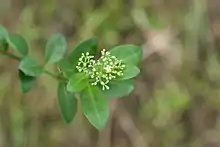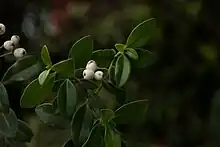| Psychotria serpens | |
|---|---|
 | |
| Inflorescence | |
 | |
| Fruit | |
| Scientific classification | |
| Kingdom: | Plantae |
| Clade: | Tracheophytes |
| Clade: | Angiosperms |
| Clade: | Eudicots |
| Clade: | Asterids |
| Order: | Gentianales |
| Family: | Rubiaceae |
| Genus: | Psychotria |
| Species: | P. serpens |
| Binomial name | |
| Psychotria serpens | |
| Synonyms[1] | |
| |
Psychotria serpens, the creeping psychotria, is a species of flowering plant in the family Rubiaceae, native to Peninsula Malaysia, Southeast Asia, southeastern China, Hainan, Taiwan, the Ryukyu Islands, and central and southern Japan.[1][2] A creeping or climbing perennial liana, it is typically found in thickets and forests, from 100 to 1,400 m (300 to 4,600 ft) above sea level.[3] It is often substituted for "Caulis Trachelospermi" (Trachelospermum jasminoides) in traditional Chinese medicine preparations sold to people with cancer.[4]
References
- 1 2 "Psychotria serpens L." Plants of the World Online. Royal Botanic Gardens, Kew. Retrieved 3 January 2023.
- ↑ Wilkes, John (1826). "28. Psychotria serpens". Encyclopædia Londinensis. London. p. 506.
- ↑ "蔓九节 man jiu jie". Flora of China. efloras.org. 2023. Retrieved 3 January 2023.
- ↑ Chao-Zhan Lin; Ai-Zhi Wu; Ying Zhong; Yu-Mei Wang; Guang-Tian Peng; Xian-Jun Su; Bing-Xin Liu; Yun Deng; Chen-Chen Zhu; Cui-Xian Zhang (2015). "Flavonoids from Psychotria serpens L., a Herbal Medicine with Anti-Cancer Activity". Journal of Cancer Research Updates. 4 (2). doi:10.6000/1929-2279.2015.04.02.3.
This article is issued from Wikipedia. The text is licensed under Creative Commons - Attribution - Sharealike. Additional terms may apply for the media files.